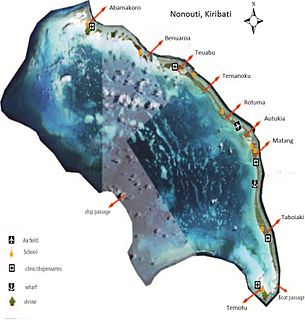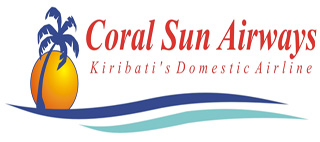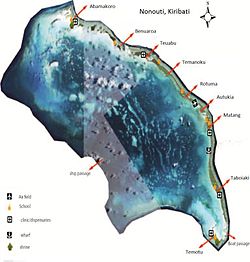
Kiribati, officially the Republic of Kiribati, is an independent island nation in the central Pacific Ocean. The permanent population is over 119,000 (2020), more than half of whom live on Tarawa atoll. The state comprises 32 atolls and one raised coral island, Banaba. They have a total land area of 811 square kilometres and are dispersed over 3.5 million km2 (1.4 million sq mi).

The Gilbert Islands are a chain of sixteen atolls and coral islands in the Pacific Ocean, about halfway between Papua New Guinea and Hawaii. From 1976 to 1979, they were the “British colony of the Gilbert Islands”, and before that, from 1916 to 1975, they were the “Gilbert and Ellice Islands colony”. They constitute the main part of the nation of Kiribati.
Gilbertese or taetae ni Kiribati, also Kiribati, is an Austronesian language spoken mainly in Kiribati. It belongs to the Micronesian branch of the Oceanic languages.
Ieremia Tienang Tabai is an I-Kiribati politician who served as the first Beretitenti President of the Republic of Kiribati, after being the youngest ever Chief minister of the Commonwealth of Nations and then becoming the youngest ever head of State. During his presidency, he was described as being the most able leader of the Pacific island states.

Tarawa is an atoll and the capital of the Republic of Kiribati, in the central Pacific Ocean. It comprises North Tarawa, which has 6,629 inhabitants and much in common with other more remote islands of the Gilberts group, and South Tarawa, which has 56,388 inhabitants as of 2015, half of the country's total population. The atoll was the site of the Battle of Tarawa during World War II.
The music of Kiribati has been less affected by Western culture than most other Pacific island cultures since Europeans did not arrive in Kiribati until 1892. The national anthem of Kiribati is "Kunan Kiribati", by I.T. Uriam; it was adopted upon independence in 1979.

Abemama (Apamama) is an atoll, one of the Gilberts group in Kiribati, and is located 152 kilometres southeast of Tarawa and just north of the Equator. Abemama has an area of 27.37 square kilometres and a population of 3,299 as of 2015. The islets surround a deep lagoon. The eastern part of the atoll of Abemama is linked together by causeways making automobile traffic possible between the different islets. The outlying islands of Abatiku and Biike are situated on the southwestern side of the atoll.

UTC+12:00 is an identifier for a time offset from UTC of +12:00.

Dance in Kiribati includes various styles unique to the island nation. The uniqueness of Kiribati dance when compared with other forms of Pacific Islands dance is its emphasis on the outstretched arms of the dancer and the sudden birdlike movement of the head. The Frigate bird on the Kiribati flag refers to this bird-like style of Kiribati dancing. Most dances are in the standing or sitting position with movement limited and staggered.
Contemporary Kiribati culture is centered on the family, the church and the sea.

Nonouti is an atoll and district of Kiribati. The atoll is located in the Southern Gilbert Islands, 38 km north of Tabiteuea, and 250 km south of Tarawa. The atoll is the third largest in the Gilbert Islands and is the island where the Roman Catholic religion was first established in Kiribati, in 1888.
The Kiribati National Championship is the top division of competitive football in the nation of Kiribati, founded in 2002 by the Kiribati Islands Football Association (KIFA), the nations football governing body. The association and the National Championships are based in the capital city, South Tarawa.

The Roman CatholicDiocese of Tarawa and Nauru in Kiribati and Nauru is a suffragan diocese of the Archdiocese of Suva. It was erected as the Vicariate Apostolic of Gilbert Islands in 1897, with see in Tanaeang from 1936 to the end of 1950s, and later elevated to as the Diocese of Tarawa in 1966. There was a name change in 1978 and, in 1982, the diocese was split from the Mission sui iuris of Funafuti. The diocese currently has jurisdiction over all of Kiribati and Nauru.
Autukia is a settlement in Kiribati it had a population of 112 in the 2010 census. It is located on Nonouti atoll; to its north are Abamakoro, Benuaroa, Teuabu, Temanoku and Rotuma, while Matang(the administrative centre), Taboiaki and Temotu are to the south.
Umantewena is a settlement on the Nonouti atoll in Kiribati.
According to 2010 government statistics, Christian groups form about 96% of the Kiribati population by census counts, most of whom are either Catholic or members of the Kiribati Uniting Church. Persons with no religious affiliation account for about 0.05% of the population. Members of the Catholic Church are concentrated in the northern islands, while Protestants are the majority in the southern islands.
Education in Kiribati is free and compulsory from age 6 to 14, which includes primary school through grade six, and Junior Secondary School for three additional grade levels. In 1998, the gross primary enrollment rate was 84.4 percent, and net primary enrollment rate was 70.7 percent. School quality and access to education are better in urban areas; schools in small communities on isolated islands are expensive to maintain. Mission schools are slowly being absorbed into the government primary school system.
The 2009 Kiribati ferry accident was the sinking, on 13 July 2009, of an inter-island ferry in the south Pacific nation of Kiribati. The accident is believed to have killed 33 of the ship's 55 passengers and crew.

Coral Sun Airways is the younger of two Kiribati airlines, established in January 2009. The airline operated domestic service to all 17 airports in the Gilbert Islands, but stopped any regular service and offers only on-demand and chartered flights. In 2015 it purchased one new, larger aircraft, capable of flying to the Phoenix Islands and Line Islands. There was no domestic nor international service to these remote archipelagos to the east of the Gilbert Islands, having 8,800 and 20 inhabitants, respectively, except for one weekly flight on Fiji Airways between Honolulu and Kiritimati (Christmas) Island among the Line Islands, and Air Kiribati domestic flights between the Line Islands.

Air Tungaru was the first airline of Kiribati. As the predecessor of current Air Kiribati, it was Kiribati's national flag carrier. Air Tungaru's main base was the international airport at Kiribati's capital, South Tarawa. From there, regular service was provided to all 16 domestic airports in the Gilbert Islands.










